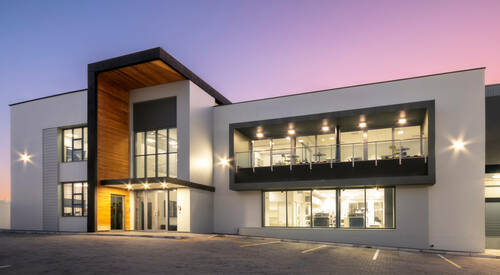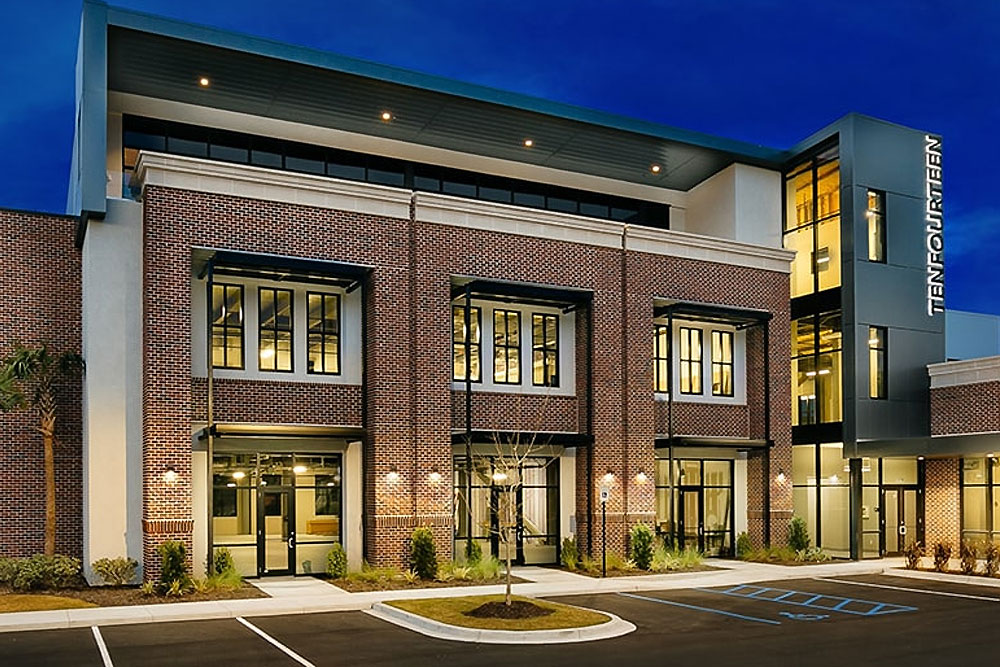The Influence of commercial architects on City Skylines and Urban Identity
Discover the Ingenious Providers Supplied by Commercial Architects for Your Next Job
Commercial architects play a necessary role fit the developed setting. They mix performance with aesthetic appeal, producing rooms that reverberate with brand identification. These experts utilize ingenious design options, sustainable methods, and advanced modern technologies to boost customer experiences. Their collaborative strategy warranties placement with client visions and functional needs. Nevertheless, the level of their services commonly expands past style. The following actions in comprehending exactly how these architects browse complex task needs may stun you.
Comprehending the Role of Commercial Architects
Although the function of industrial architects may differ relying on the certain project, their primary function focuses on developing useful and cosmetically enticing spaces for organizations. These professionals are entrusted with recognizing the one-of-a-kind needs of each client, whether it be a retail store, office structure, or industrial facility. They conduct thorough site evaluations and collaborate with stakeholders to ensure that the design straightens with the company goals and brand identity.Commercial architects likewise browse various regulatory requirements, safeguarding conformity with zoning regulations and building codes. Their proficiency reaches producing sustainable styles that promote power effectiveness and ecological duty. In addition, they handle the task's timeline and budget plan, coordinating with service providers and designers throughout the building procedure. By mixing creative thinking with technical knowledge, business architects play a necessary role in changing conceptual ideas into substantial truths, inevitably improving the performance and charm of industrial rooms.
Ingenious Layout Solutions for Unique Rooms
As business areas significantly demand distinctiveness to stand out in open markets, cutting-edge design options have become essential for architects. These professionals take advantage of their creativity and technical knowledge to craft distinct environments that reflect brand identity and enhance customer experience. By incorporating cutting-edge technology and materials, industrial architects can transform regular spaces right into enchanting places that engage consumers and inspire employees.Architects utilize numerous methods, such as adaptive reuse, which renews existing frameworks while maintaining their historic importance. They likewise explore unusual layouts and multifunctional rooms that cater to diverse demands, guaranteeing versatility for future growth.Furthermore, the incorporation of biophilic layout-- bringing nature inside your home-- creates welcoming ambiences that promote wellness - commercial architects. This interest to information in ingenious design not only addresses visual concerns however additionally fosters area and cooperation. Ultimately, these tailored solutions enable services to prosper in an ever-evolving landscape, setting them besides rivals
Lasting Architecture Practices
Lasting style techniques have actually arised as a pivotal emphasis for industrial architects looking for to create impactful designs that reverberate with environmental stewardship. These methods prioritize the use of renewable energies, energy efficiency, and marginal waste, mirroring a dedication to lowering the eco-friendly footprint of buildings. Architects include products that are sustainably sourced or recycled, ensuring that building and construction approaches align with ecological principles.Furthermore, the assimilation of green roofs and wall surfaces enhances biodiversity while boosting energy efficiency. Effective water management systems, such as rain harvesting, contribute to sustainability by preserving water resources. Natural ventilation and daylighting techniques are additionally utilized to optimize interior settings, minimizing reliance on man-made heating and illumination.
Integrating Technology in Architectural Styles
An enhancing number of business architects are accepting innovation as a transformative component in building layout. By leveraging advanced software application tools such as Structure Info Modeling (BIM), architects can develop thorough 3D representations of jobs, enabling boosted visualization and partnership among stakeholders. This technology facilitates real-time adjustments, reducing errors and improving the design process.Additionally, architects are incorporating clever structure innovations into their layouts, which boost power effectiveness and resident comfort. Features such as automated lighting, climate control, and security systems can be effortlessly integrated, advertising sustainable methods and minimizing operational costs.The use virtual and increased reality likewise allows clients to experience designs before construction starts, offering important understandings into spatial partnerships and aesthetic selections. Ultimately, the assimilation of innovation in architectural styles not only cultivates technology yet additionally assures that projects are performed with accuracy and aligned with contemporary needs.

Job Management and Coordination Providers
Effective task management and coordination solutions are vital for the effective implementation of business building jobs. These services ensure that all facets of a task, from first style to final building, are perfectly integrated. Commercial architects play a considerable function in working with in between different stakeholders, including clients, contractors, and suppliers, to keep clear communication and alignment on task goals.By applying organized methods, architects can take care of timelines, budget plans, and resources efficiently, lessening delays and cost overruns. They use project monitoring software program and tools to track progression, manage documents, and assist in collaboration among group members.Additionally, these solutions include danger evaluation and reduction techniques, validating potential challenges are identified and attended to proactively. The outcome is a streamlined process that improves total task efficiency and quality, ultimately bring about a successful result that fulfills the customer's vision and assumptions.
Regulatory Compliance and Zoning Assistance
Effective regulatory conformity and zoning assistance are vital for the success of any commercial task. Architects have to possess a deep understanding of local guidelines and zoning laws to assist clients via the complexities of the approval process. This know-how not only ensures adherence to legal needs however likewise aids enhance project style and functionality.
Browsing Local Regulations
Just how can business architects assure their designs line up with regional regulations? By remaining educated concerning the ever-evolving landscape of building ordinance and regional ordinances, architects play a vital function in guaranteeing compliance. They perform thorough study to understand the specific regulations regulating products, safety standards, and building techniques suitable to every job. Working together carefully with local authorities, commercial architects can maneuver via the intricacies of regulatory frameworks properly. They also promote essential authorizations and examinations, enhancing the approval procedure. This positive approach not only minimizes potential legal difficulties but additionally enhances job performance. Inevitably, their competence in navigating neighborhood guidelines equips clients to realize their vision while sticking to all called for requirements and standards.
Zoning Regulation Expertise
Zoning legislation expertise is essential for commercial architects steering via the complexities of land usage guidelines. These architects have thorough expertise of neighborhood zoning codes, which govern property growth, land usage, and building specifications. By comprehending these laws, they aid clients navigate the frequently detailed authorization processes needed for building and construction jobs. Their expertise assurances compliance with zoning regulations, decreasing the danger of task hold-ups or lawful complications.Additionally, industrial architects provide useful assistance in getting necessary licenses and differences, assisting in smoother interactions with local authorities. They additionally offer tactical suggestions to optimize site design and optimize the potential of a property while sticking to zoning constraints. Inevitably, their zoning regulation effectiveness plays a crucial role in the successful awareness of commercial jobs.
Collective Methods With Clients and Stakeholders
Effective business style depends upon the capability to foster strong collaboration with customers and stakeholders throughout the design procedure - commercial architects. Architects participate in open dialogues, making certain that all parties' visions and demands are integrated into the task. This joint strategy begins in the preliminary phases, where architects carry out workshops and brainstorming sessions, permitting clients to articulate their objectives and concerns.Stakeholder input is equally important; architects commonly organize conferences with community participants, neighborhood federal governments, and various redirected here other appropriate entities to gather varied perspectives. By using visualization devices, have a peek at these guys such as 3D modeling, architects assist in much better understanding and communication.This iterative comments procedure not just boosts layout quality however additionally constructs count on, bring about more effective outcomes. Ultimately, the collaborative viewpoint of industrial architects changes ideas into practical rooms that reflect the desires of customers and the broader neighborhood, guaranteeing an unified connection throughout the task lifecycle

Frequently Asked Concerns
What Is the Normal Timeline for an Industrial Design Job?
The typical timeline for a commercial architecture project varies, normally spanning 6 to 18 months. Elements affecting this period consist of job complexity, governing authorizations, and customer responsiveness, affecting each stage from design to construction completion.
How Do Commercial Architects Fee for Their Providers?
Commercial architects generally charge based upon job scope, intricacy, and dimension. Typical fee structures consist of hourly rates, repaired costs, or percentage-based fees computed from the complete construction price, making sure openness and positioning with client assumptions.
Can Commercial Architects Help With Interior Design?
Commercial architects can indeed help with interior decoration, incorporating capability and visual appeals. Their competence warranties cohesive areas look at this website that straighten with building vision, improving individual experience while fulfilling regulative requirements and client goals with ingenious layout remedies.
What Sorts of Customers Do Commercial Architects Generally Collaborate With?
Commercial architects usually work together with varied customers, consisting of services, government entities, universities, and charitable organizations (commercial architects). Each client seeks tailored building remedies to fulfill certain practical and aesthetic requirements for their tasks and settings
Exactly How Do Commercial Architects Stay Upgraded With Design Fads?
Commercial architects remain updated with layout patterns through continual education and learning, participating in market seminars, participating in specialist networks, and researching emerging technologies. They likewise collaborate with other professionals to gain insights right into innovative materials and layout methods.